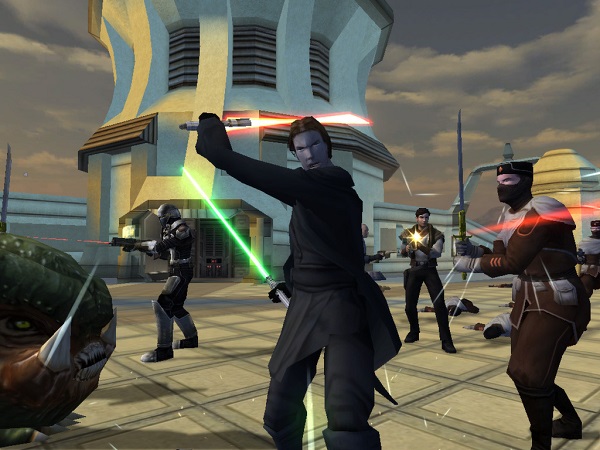Continuing our look back at the selected highs and lows of original storytelling in Star Wars games. You can find Episode One: The Golden Years HERE.
SPOILER ALERT – As is regularly the case in this column, we will be going into key plot spoilers for certain games. Enter at your own risk!
The release of X-Wing Alliance in February 1999 signalled the end of an era for Star Wars games. The previous seven years had seen LucasArts achieve massive success by creating innovative original games based around Star Wars, crafting stories that not only explored fresh perspectives on the action in the movies but in some cases allowed players to feel like they were carving their own niche in the universe. The fanbase, already enjoying the resurgence of interest in the property in the mid-90s, slurped every last drop of it up like catnip. It wasn’t just a good time to be a Star Wars fan, or a gamer: it was a pretty fantastic time to be a Star Wars gamer, with LucasArts crafting stories that only enhanced fans’ love of the universe.
It wasn’t to last.
EPISODE TWO: THE PREQUEL YEARS (1999-2005)
The release of The Phantom Menace saw a distinct change in LucasArts’ creative focus as it pertained to Star Wars. The emphasis was taken off original ideas and expanding the lore, and placed on straight adaptations of the movies’ key scenes and Star Wars-ized versions of whatever genre was hot that week (Super Bombad Racing, Jedi Power Battles, Star Wars Demolition). Star Wars: Force Commander (2000) had a veneer of story, but only in that the player character defects to the Alliance after finding out that the Empire killed his father: Otherwise, it’s the same old ‘greatest hits’ tour of the OT LucasArts had done many times before, and done better.
2001
Star Wars: Obi-Wan (2001) makes a half-hearted attempt to flesh out what is more or less yet another Phantom Menace game where you play through the movie as Obi-Wan. Similarly, Battle for Naboo and Starfighter weaves solid but unspectacular plots around the events of the film, but does nothing that particularly sticks in the memory.
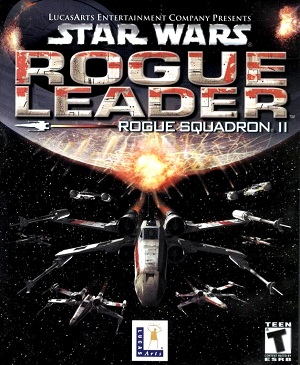 This year also saw the release of Rogue Squadron II: Rogue Leader, which benefited from the extra power of the Nintendo Gamecube, but in narrative terms achieves about the same as the original: A cool look at the history of Rogue Squadron, but essentially another retread of the highlights of the OT. As with the original, this isn’t really a fault with the game per se but it further cemented the lessening ambition of LucasArts when it came to Star Wars stories.
This year also saw the release of Rogue Squadron II: Rogue Leader, which benefited from the extra power of the Nintendo Gamecube, but in narrative terms achieves about the same as the original: A cool look at the history of Rogue Squadron, but essentially another retread of the highlights of the OT. As with the original, this isn’t really a fault with the game per se but it further cemented the lessening ambition of LucasArts when it came to Star Wars stories.
2002
Thankfully Jedi Knight 2: Jedi Outcast signalled something of a return to LucasArts’s Nineties form, or at least close enough to reassure. As a story, its only real mistake is to have Kyle Katarn start the game having returned to the mercenary life, only to pick up the lightsaber once more further into the game. It’s an unnecessary retread of Jedi Knight, with the game coming to life once Katarn unleashes those oh-so-sweet saber moves.
Once the plot kicks into gear it does a good job of developing Katarn, who is by this stage well on his way to becoming a fully-fledged Jedi. Of particular note is his deepening relationship with his longtime offsider Jan Ors, a rare example of a heroic romance that’s allowed to develop with some degree of subtlety, and is of particular interest as it was released the same year as Attack of the Clones, gently flying in the face of the strict ‘no nookie’ rule exercised by the Jedi in the Prequel era. Touches like this and Luke Skywalker’s marrying Mara Jade elsewhere in the EU pointed to Luke’s Jedi Order being fashioned quite differently to the old regime – it’ll be interesting to see how this is approached in the new movies, if at all.
 Speaking of Luke, he also shows up several times in the game along with Lando Calrissian (Voiced by none other than Billy Dee Williams himself). Gimmicky as they may be, these cameos do a lot to establish ties between Katarn and the original characters. Coming at a time when a fanbase was becoming increasingly disillusioned with the direction of the new movies, and therefore were welcoming to the idea of the classic characters and cast showing up again, also played a large part in the success of Jedi Outcast. While the story lacks the innovation of the first two games, strong characterization and tight plotting that preserved the atmosphere of the movies keeps it enjoyable and a cut above the standards of the day.
Speaking of Luke, he also shows up several times in the game along with Lando Calrissian (Voiced by none other than Billy Dee Williams himself). Gimmicky as they may be, these cameos do a lot to establish ties between Katarn and the original characters. Coming at a time when a fanbase was becoming increasingly disillusioned with the direction of the new movies, and therefore were welcoming to the idea of the classic characters and cast showing up again, also played a large part in the success of Jedi Outcast. While the story lacks the innovation of the first two games, strong characterization and tight plotting that preserved the atmosphere of the movies keeps it enjoyable and a cut above the standards of the day.
The other big narrative-heavy release of 2002 was Bounty Hunter on the Gamecube. A loose prelude to Attack of the Clones, the game stars Jango Fett and charts the circumstances that led to his introduction to Count Dooku and large-scale DNA donating. Considered something of a mess in gameplay terms, it at least has a fun story behind it which explores the underworld of the Star Wars universe.
2003
This year saw further sequels land in the Jedi Knight and Rogue Squadron series. Jedi Knight : Jedi Academy, while featuring a solid but unremarkable storyline involving a Dark Jedi cult, it’s bolstered by the return of Luke Skywalker and introduced customizable player characters to the franchise. Rogue Squadron III: Rebel Strike flirts with redundancy by reprising its ducking and weaving around the principal sequences of the OT, but picks up with a level set on Geonosis that sees Prequel-era tech come into play, the first time an OT-centric game incorporated Prequel elements.
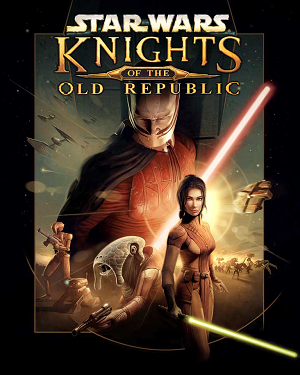 However, only one game truly mattered in 2003: Knights of the Old Republic. It’s amazing that it took until now for a Star Wars videogame RPG to be made, but Bioware (With LucasArts publishing) made the wait worth it and then some.
However, only one game truly mattered in 2003: Knights of the Old Republic. It’s amazing that it took until now for a Star Wars videogame RPG to be made, but Bioware (With LucasArts publishing) made the wait worth it and then some.
You start off as an anonymous Republic soldier who wakes up in the middle of an attack on his ship. Teaming up with another soldier, Carth Onasi, and escaping the disintegrating ship to the city planet of Taris, you set about rescuing Jedi Bastila Shan. Things naturally get complicated as you start discovering Force abilities, with Bastila convincing the Jedi Council to allow you to train as a Jedi. Mysterious visions lead to the revelation of a series of Star Maps which when combined reveal the location of the Star Forge, a starship forge of immense power. Also searching for the Star Forge is Sith Lord Darth Malak, resulting in a race to the superweapon as you uncover your past.
It cannot be understated just how impactful KOTOR was on release. It wasn’t just that it was one of the best RPGs to come along in years, and certainly the best to ever appear on console; nor was it just that, with the stories of Star Wars games becoming increasingly homogenized in recent years, seemingly content to string together the same old scenes from the movies over and over again, we were getting what to many fans felt almost like a reboot of the franchise. It was that this game provided the purest-feeling Star Wars experience in years, certainly miles above the prequel films.
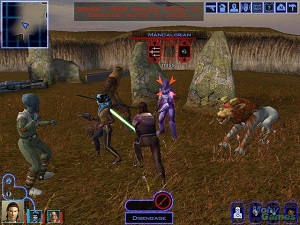 This is due to the cleverness of Bioware’s writing, with sharp and vibrant character writing that left anything George Lucas came up with at the time in the dust: several characters, like Bastila Shan, Darth Malak and the endearingly amoral battle droid HK-47 would become fan favourites and be reprised several times in the wider EU. Bioware also cleverly constructed the game’s plot to echo certain key moments of the OT. The ship boarding you escape at the start of the game, for example, feels very reminiscent of the capture of the blockade runner in A New Hope. Another escape sequence, this time from Darth Malak’s ship the Leviathan, recalls the springing of Princess Leia from the Death Star in the same film, and the final duel with Malak as the Republic and Sith fleets go at it at the Star Forge has all the awesomeness of the space battle and Luke/Vader/Palpy face-off at the end of Jedi, minus the Ewoks. Similarly, the acquiring of HK-47 on Tatooine references the discovery of C-3PO in The Phantom Menace, only substituting a drily homicidal droid for a bumbling, effete one and excising the annoying kid. An improvement by any standards.
This is due to the cleverness of Bioware’s writing, with sharp and vibrant character writing that left anything George Lucas came up with at the time in the dust: several characters, like Bastila Shan, Darth Malak and the endearingly amoral battle droid HK-47 would become fan favourites and be reprised several times in the wider EU. Bioware also cleverly constructed the game’s plot to echo certain key moments of the OT. The ship boarding you escape at the start of the game, for example, feels very reminiscent of the capture of the blockade runner in A New Hope. Another escape sequence, this time from Darth Malak’s ship the Leviathan, recalls the springing of Princess Leia from the Death Star in the same film, and the final duel with Malak as the Republic and Sith fleets go at it at the Star Forge has all the awesomeness of the space battle and Luke/Vader/Palpy face-off at the end of Jedi, minus the Ewoks. Similarly, the acquiring of HK-47 on Tatooine references the discovery of C-3PO in The Phantom Menace, only substituting a drily homicidal droid for a bumbling, effete one and excising the annoying kid. An improvement by any standards.
Above anything else, however, KOTOR feels like an original story at a time when Star Wars games were content to simply cling to the back of the movie plots like limpets and give scant extra food for thought. KOTOR is the work of people who love Star Wars, who are relishing the chance to tell a new story, their story, in that universe, and that love translates into one of the best Star Wars tales in all the EU.
2005
KOTOR isn’t just a classic but, in this writer’s opinion at least, the best Star Wars game ever made. Naturally, LucasArts knew that a sequel was all but mandatory, but the way they went about it would prove to be one of the first signs of increasingly erratic decision-making in the company. Handing the franchise over to Obsidian was a good move; giving them barely eighteen months to make the thing was most certainly not.
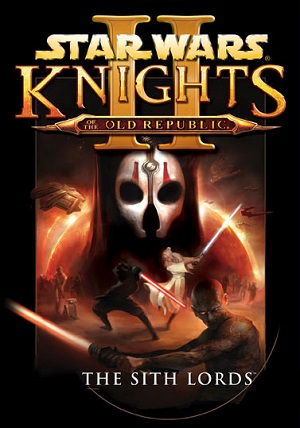 It’s a shame, because for its first two thirds Knights of the Old Republic II: The Sith Lords easily stands up to the original. Taking the role of the supposed last Jedi in the galaxy after the Sith have all but wiped the order out, you start off unable to remember your past and your connection to the Force severed. The game’s plot tasks you to piece your past together while slowly regaining your powers. Amnesia is, of course, a well-worn trope in games and the loss of powers is a fairly obvious excuse to reprise the character progression system from the first game, but what makes The Sith Lords sing is the noticeably darker tone it adopts. While the original captured the euphoric feel of A New Hope brilliantly, Obsidian responded with the series’ Empire Strikes Back – a gambit that thankfully works well, giving Obsidian plenty of opportunities to blur the traditional boundaries of light side/dark side morality and giving added weight to the choices you make, and the companions you endear or alienate.
It’s a shame, because for its first two thirds Knights of the Old Republic II: The Sith Lords easily stands up to the original. Taking the role of the supposed last Jedi in the galaxy after the Sith have all but wiped the order out, you start off unable to remember your past and your connection to the Force severed. The game’s plot tasks you to piece your past together while slowly regaining your powers. Amnesia is, of course, a well-worn trope in games and the loss of powers is a fairly obvious excuse to reprise the character progression system from the first game, but what makes The Sith Lords sing is the noticeably darker tone it adopts. While the original captured the euphoric feel of A New Hope brilliantly, Obsidian responded with the series’ Empire Strikes Back – a gambit that thankfully works well, giving Obsidian plenty of opportunities to blur the traditional boundaries of light side/dark side morality and giving added weight to the choices you make, and the companions you endear or alienate.
This ambiguity is symbolized by Kreia, who becomes an unlikely – and depending on your final alignment, highly questionable – mentor. Kreia teaches a doctrine of self-sufficiency, believing that helping the weak only teaches them to stay weak, and even aspiring to conquer the Force itself. Unsurprisingly she isn’t the warmest of characters, pretty much disliking everyone except you despite (Or perhaps because of) your blank-slate status, and she delivers some of the game’s best dialogue when snarking at your companions. Thus, it doesn’t come as a massive surprise when she is revealed to be a Sith but the predictability of the twist is just about justified by her entertainment value.
Of course, the final stages of the endgame have long been a sore point with fans of the game, and Obsidian themselves for that matter. Forced to have the game ready for shipping for the Christmas 2004 period, the game was released riddled with bugs and with significant amounts of story content cut. As a result, vanilla KOTOR 2 takes a nosedive in its final third, as it rushes to an abrupt ending with several plotlines undeveloped, or plain cut short. The shambolic state of its climax led to poor reviews and a toxic reaction from the fans, and as if LucasArts’s behaviour hadn’t been foolish enough they went on to repeatedly rebuff requests from fans for a content patch restoring the lost material.
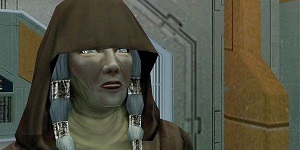 In obvious frustration at this situation, Obsidian included these discarded files with the PC version of the game, clearly in the hope that the fans could do something with them. Their instincts paid off: a fan collective calling themselves the Sith Lords Restoration Project recompiled these files, eventually releasing them as the Sith Lords Restored Content Mod in 2012. While completely fixing the game’s fractured narrative was impossible, the sizable amount of material reincorporated into the game does vastly improve the experience, providing a much more rounded and dramatically satisfying experience.
In obvious frustration at this situation, Obsidian included these discarded files with the PC version of the game, clearly in the hope that the fans could do something with them. Their instincts paid off: a fan collective calling themselves the Sith Lords Restoration Project recompiled these files, eventually releasing them as the Sith Lords Restored Content Mod in 2012. While completely fixing the game’s fractured narrative was impossible, the sizable amount of material reincorporated into the game does vastly improve the experience, providing a much more rounded and dramatically satisfying experience.
Thanks to this mod, KOTOR 2 has received a well-deserved reassessment over the last couple of years with Obsidian’s denser, more layered approach to the morality of the franchise being recognized as a bold exploration of a property that has been traditionally quite conservative in its narratives. While the original KOTOR‘s story is more cohesive and ultimately the better, the sequel more than lives up to it and is absolutely worth grabbing off Steam; just make sure you get that mod.
 The year’s other big release, Republic Commando, was a bit of bit of a welcome throwback in narrative terms, employing the same hint of realism that made the X-Wing series, and to a lesser extent Dark Forces, so engaging. This tactical FPS follows the exploits of Delta Squad, a band of elite clone commandos. Being elites, the game smartly allows them a bit more personality than their mass-produced brethren allowing the four Deltas – Boss, Fixer, Scorch and Sev – to develop and show distinct personalities over the games’s three main missions. It’s essentially Star Wars via the Dirty Dozen via Rainbow Six, and it makes for an incredibly fun combination. Much like the X-Wings you’re operating on the fringes of the big movie battles, the Special Ops-style mission structure providing a much grittier and more grounded experience than the other Prequel games that had been released thus far. Two of the missions stay close to the films, being set during the battles of Geonosis and Kashyyyk, but the highlight is the mission that takes place on an occupied republic Star Destroyer. It’s a great opportunity to look around a classic ship (Or at least, its progenitor), and exactly the kind of filling-out of the universe the Star Wars games do at their best.
The year’s other big release, Republic Commando, was a bit of bit of a welcome throwback in narrative terms, employing the same hint of realism that made the X-Wing series, and to a lesser extent Dark Forces, so engaging. This tactical FPS follows the exploits of Delta Squad, a band of elite clone commandos. Being elites, the game smartly allows them a bit more personality than their mass-produced brethren allowing the four Deltas – Boss, Fixer, Scorch and Sev – to develop and show distinct personalities over the games’s three main missions. It’s essentially Star Wars via the Dirty Dozen via Rainbow Six, and it makes for an incredibly fun combination. Much like the X-Wings you’re operating on the fringes of the big movie battles, the Special Ops-style mission structure providing a much grittier and more grounded experience than the other Prequel games that had been released thus far. Two of the missions stay close to the films, being set during the battles of Geonosis and Kashyyyk, but the highlight is the mission that takes place on an occupied republic Star Destroyer. It’s a great opportunity to look around a classic ship (Or at least, its progenitor), and exactly the kind of filling-out of the universe the Star Wars games do at their best.
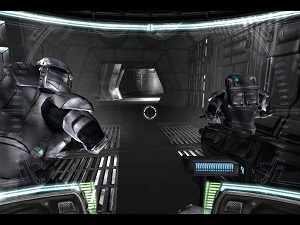 Republic Commando‘s refreshing lack of Jedi also allowed for a meatier, more visceral feel with knife melee kills resulting in blood spatters across the player’s visor and sniper shouts able to remove head – at least, non-human heads. While quaint compared to other games, these images stood in stark contrast to the sanitized, bloodless violence of the films; though with that year’s Revenge of the Sith ending in the graphic frying of Anakin Skywalker, it’s plausible that at that point LucasArts could get away with a little extra than any of the other films would’ve allowed. Either way, Republic Commando managed to tap into that the old LucasArts’s instincts, creating a game that stands up well against the classics of the Nineties.
Republic Commando‘s refreshing lack of Jedi also allowed for a meatier, more visceral feel with knife melee kills resulting in blood spatters across the player’s visor and sniper shouts able to remove head – at least, non-human heads. While quaint compared to other games, these images stood in stark contrast to the sanitized, bloodless violence of the films; though with that year’s Revenge of the Sith ending in the graphic frying of Anakin Skywalker, it’s plausible that at that point LucasArts could get away with a little extra than any of the other films would’ve allowed. Either way, Republic Commando managed to tap into that the old LucasArts’s instincts, creating a game that stands up well against the classics of the Nineties.
Unfortunately, it also came at a time when Star Wars burnout was at an all-time peak, with cynicism towards the Prequels and their accompanying games leading to Republic Commando selling poorly. It deserved much better, especially as things would not improve for LucasArts over the next few years…
TO BE CONCLUDED IN EPISODE THREE: THE HANGOVER YEARS

